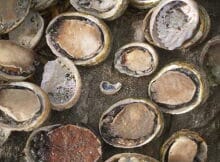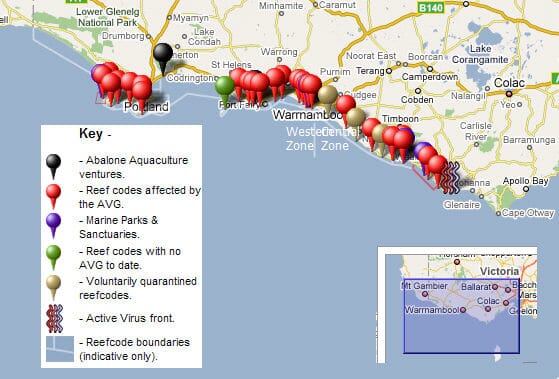
Photo: Vada.com
This year, the Tasmanian abalone industry was also hit by an outbreak of Abalone Viral Ganglioneuritis. The emergency response involved an extensive surveillance programme, including diver observation of the health of abalone over a wide area and the laboratory testing of more than 1600 samples from the wild.
In its most recent report the Tasmanian government said that there is no evidence of active disease in Tasmania’s wild abalone population and only the one positive DNA test.
Minister for Primary Industries and Water David Llewellyn said that the quick biosecurity measures were credited for saving the $100 million dollar industry, but it was a different story when the virus hit Victoria.
Although the disease was detected in 2005, the Victorian Abalone Divers Association say that de-stocking, cleaning and disinfecting of the land based aquaculture farms wasn't completed until July 2006. It is said to have taken over 5 months of discharging untreated effluent into the marine environment before the virus took hold in wild stocks outside one of the aquaculture farms. Since then it has spread rapidly.
Almost 200 kilometers of Victorian Coast is now affected and the virus shows with no signs of weakening. Current data show that its progression is somewhere between 5 and 10 kilometers every month.
One of the puzzling aspects of the rapid spread is how the abalone virus seems to be able to jump large distances at a time, hindering the ability to monitor gradual progression.
Some experts believe that human activity may assist the virus in moving. This could be by virus particles, could end up on commercial or recreational divers gloves and wet suits etc, and be moved from one location to the next.
Another possibility is that during periods of extreme weather when divers are unable to go in the water the virus may have enough time to move into one farm infect and then move on again before the divers have a chance to monitor its progression.
Another theory argues that the virus may attach itself to drift seaweed and move in the currents from one location to the next.
According to the Victoria Abalone Divers Association, Abalone Viral Ganglioneuritis (AVG) attacks the ganglion nerve in the abalone. "AVG replicates in the ganglion nerve and impairs the function of the nervous system of the abalone. The affected abalone are unable to move about or hold on. They find it impossible to feed or maintain being attached to their home site rocks. The abalone then fall off and are eaten by predators or die and rot on the bottom."
The Ganglioneuritis Virus is highly pathogenic with rapid onset of less than 48 hours and death in less than 6 days. To date there is 100% mortality of abalone if they are infected. In the wild, when the Virus has moved through and infected a reef area there have been mortalities of up to 95%. One such infected reef area recorded mortalities of 90% in just two weeks.
But the consequences of the virus may reach beyond merely the abalone industry. It is uncertain what effect all the dead abalone will have upon the environment, but it is possible that the whole eco-system may change, and grow over as those species that rely on abalone will have to find other sources of food.
One review of the situation by a group of international molluscan disease experts highlighted the Australian lack of awareness that its small abalone farming sector (
The report stated that the Australian abalone industry has "little awareness of this bio-security risk and concluded that "careful analysis might find that the abalone farming presents a larger risk to Australia’s public good than its long term potential benefit can justify."
Map of Abalone Spread

Stopping the Virus
In a report for the association, Judith Handlinger wrote that "no amount of knowledge can undo the events leading to the emergence of this disease in Western Victoria, and any suggestions of eradication from this area are unrealistic."
Her major concern was to "provide the optimum conditions for the industry to continue to operate despite the presence of this virus, and to prevent human activity that may further spread the virus."
In order to do this the Victorian Abalone Divers Association say that urgent action is needed. They say that the Government needs to work with the abalone industry and public awareness needs to be raised. The association also stresses the need to break the state up into disease zones in order to stop the transmission of the disease.
The association recommends restricted commercial and recreational diver access to disease affected areas, along with a ban on moving live abalone from Western Victoria to open circuit holding tanks.
"It is important that the government takes a bigger role in monitoring the problem, especially around the coast", says the Association. Effective policies against abalone thieves need to be reinstated and there needs to be some kind of workable plan to restore the abalone populations.
In order for any of this to be successful the Abalone Divers Association stress the need for proper scientific monitoring and research.
Despite their concerns, the Victorian Abalone Divers Association say that they believe all businesses have a right to operate and all businesses have a right to grow without impacts by others. Their concern is that "businesses that operate in the natural marine environment should adopt a proactive approach to ensuring the marine eco-system is protected and the operations are safe and sustainable."
The Abalone Council of Australia (ACA) must overcome previous problems of cohesion that have beset it and rise to face the nation wide challenge of getting Australia’s management and research agencies to rationally and accurately assess the biosecurity risk created by the farm sector.
The question must be seriously asked and analysed; given that Australia has the most valuable and sustainable abalone fishery in the world can they afford the risk of having a farm sector as well?

